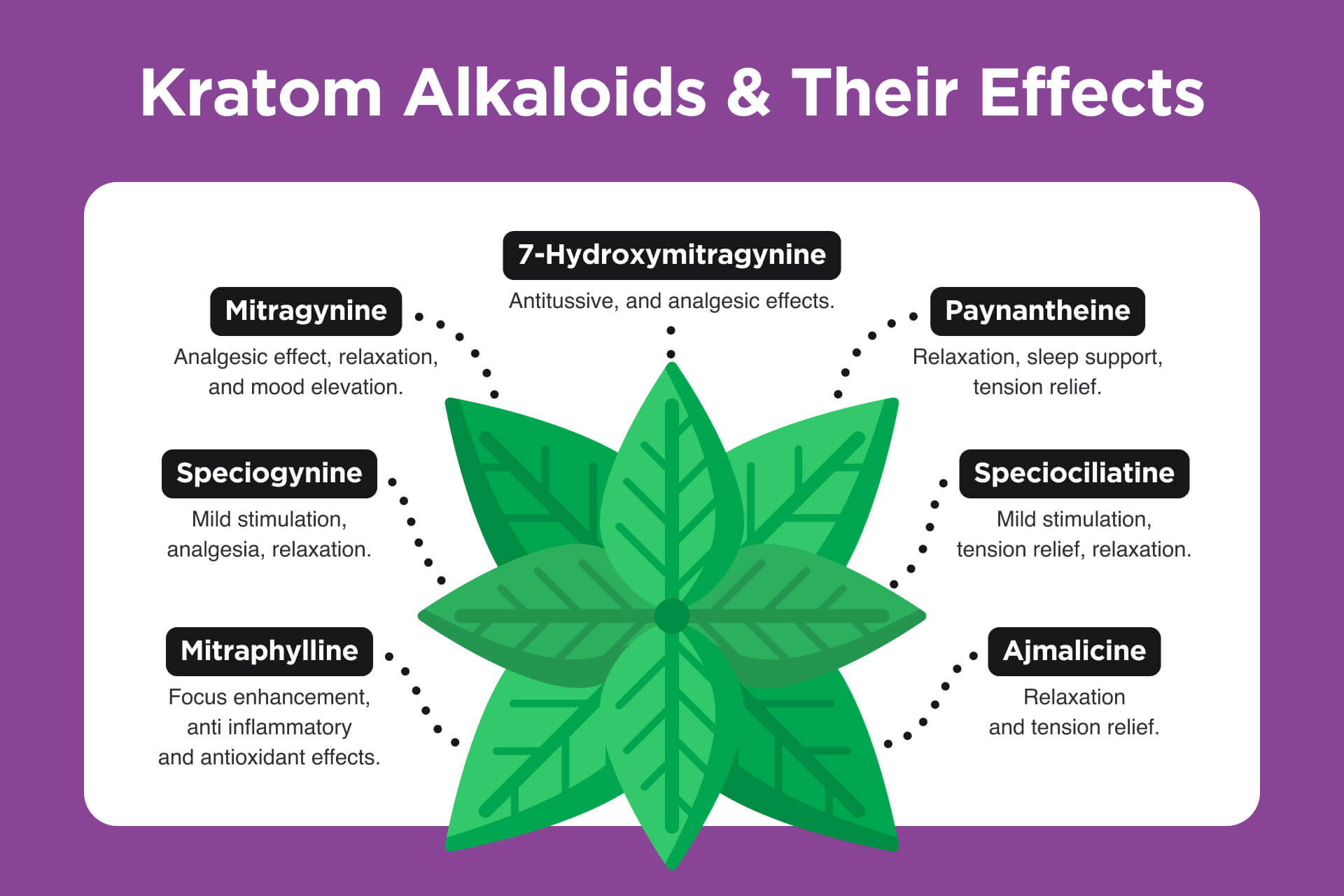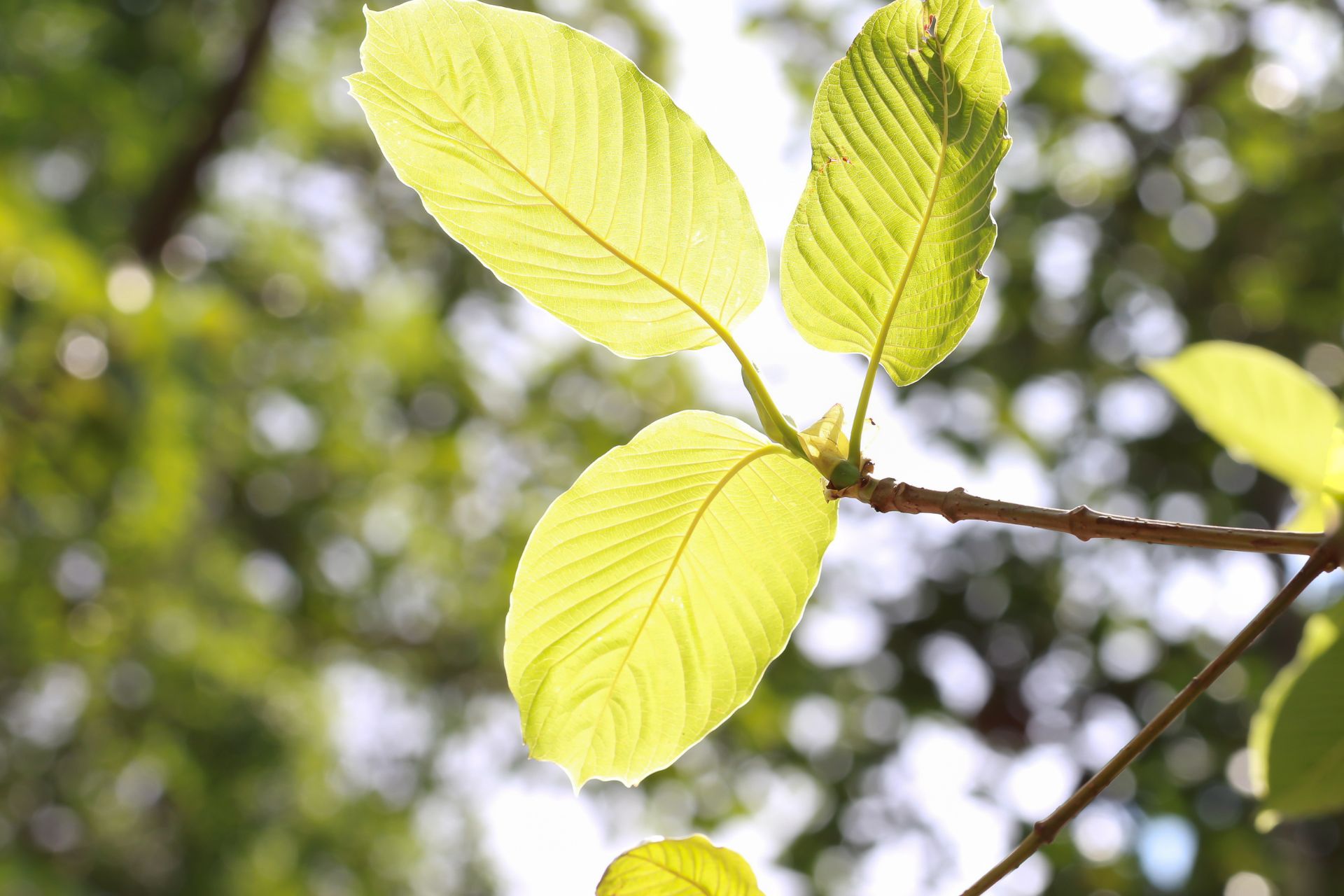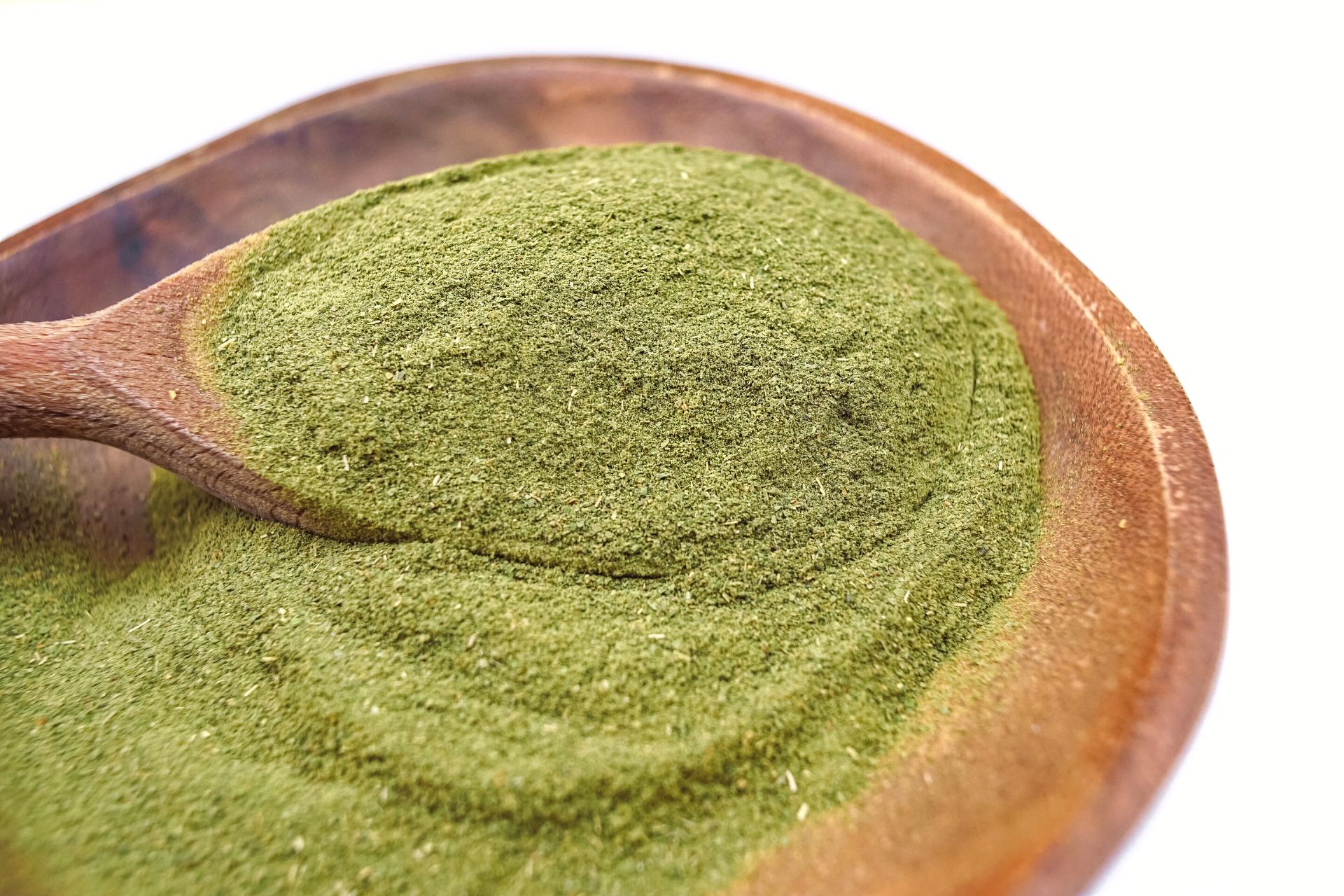Understanding Kratom Alkaloids and Their Properties
Understanding Kratom Alkaloids and Their Properties
What is an alkaloid?
A kratom alkaloid is a naturally occurring, organic compound comprising one or more nitrogen atoms. Depending on its chemical structure, it may also have hydrogen, carbon, sulfur, oxygen, chlorine, and phosphorus. It comes from amino acids and has varying effects.
Since it’s difficult to synthesize these compounds in labs, scientists usually isolate them from living organisms. Although plants are their primary sources, some animals also create them. There are also a few synthetic elements with similar chemical compositions to alkaloids.
These compounds are key components of food, drinks, and various substances, and have several biological impacts on people and animals.
Studies suggest they possess antifungal, anesthetic, analgesic, anti-cancer, anti-inflammatory, antimicrobial, and neuropharmacological properties.
What are kratom alkaloids, and how do they work?
Otherwise called Mitragyna speciosa, kratom is a tropical flowering plant of the Rubiaceae family. These trees grow in Southeast Asian nations such as Malaysia, Thailand, Myanmar, and Indonesia. People believe the leaves and other extracts of the plant have medicinal uses.
Kratom recently gained acceptance in the west and is available in different forms, such as powder, capsules, extracts, gummies, and tea.
Alkaloids are the most active ingredients in kratom and are responsible for the plant’s effects. Since the majority of these compounds aren’t available in other herbs, people consume Mitragyna speciosa to experience their impacts.
Mitragynine and 7-hydroxymitragynine are the most common naturally occurring compounds in Mitragyna speciosa. Many even assume they’re the only alkaloids in the plant’s leaves. Studies note that the kratom chemical structure contains more than 50 other ingredients.
Although all alkaloids in kratom contain the same chemical elements, each has a unique structure. These compounds have different effects, and their quantity in each strain varies. The alkaloid levels determine kratom’s specific influence on your system.

Let’s explore various alkaloids in kratom and how they work below.
Mitragynine
Mitragynine is an indole-based compound, and the most commonly isolated ingredient in Mitragyna speciosa. Anecdotal evidence suggests its leaves and other extracts may have many therapeutic properties.
The management of soreness is the main benefit of this compound. This pure alkaloid may also be a potent energy booster and relaxant, depending on the amount consumed.
Its kratom molecular structure shows it contains several hydrogen, oxygen, nitrogen, and carbon atoms. The mitragynine in each strain differs. It can be as high as 66% of the total alkaloid content in Thai variants and only 12% in Malaysian strains.
This compound is a selective agonist that binds to the same receptors as morphine and other opioids attach to in the brain. As a result, mitragynine in kratom may reverse or suppress the effects of these chemicals.
Due to the possible holistic and recreational benefits of this compound, many Southeast Asians have been consuming kratom for ages. Many westerners also use it today. The herb retains its composition whether consumed as capsules, powder, leaves, extracts, or tea.
The compound is also available in three other Mitragyna species, including M. rotundifolia, M. javanica, and M. hirsuta. The mitragynine content of each varies.
7-hydroxymitragynine
Also referred to as 7-OH, 7-hydroxymitragynine is a naturally occurring indole alkaloid in kratom. It’s a byproduct of mitragynine and is considered the second most important component of the plant.
The kratom formula of 7-OH is similar to the mitragynine structure. These two alkaloids bind to the same receptors in the brain. The similarities come from the relationship between both elements during their synthesis.
As Mitragyna speciosa grows, it creates mitragynine. Once the plant matures, the natural compound undergoes oxidation and converts to 7-hydroxymitragynine. Since red vein kratom is the later stage of the crop, it features more 7-OH than other veins.
While 7-OH only represents as much as 2% of alkaloids in kratom, it plays a crucial role in the herb’s potential effects. This compound reportedly has analgesic abilities and may relieve discomfort. It could also reduce the symptoms of sleeplessness.
Speciociliatine
Speciociliatine is an opioid-like alkaloid with several potential effects and comprises up to 2.9% of the herb’s dried leaf form. This compound is a stereoisomer of mitragynine, featuring the same kratom chemical composition but different atom arrangements.
Like other alkaloids, speciociliatine attaches to certain receptors in the brain. Researchers debate whether this compound is an agonist or an antagonist. While some suggest it makes sensory neurons produce the intended response, others claim it prevents any reaction.
There’s a lack of research on the exact effects of this alkaloid on your body. Due to its structural and chemical similarity to mitragynine, speciociliatine may have the same properties as the main ingredient of kratom.
The potential benefits of this compound may include boosting energy, improving mood, and alleviating discomfort. The highest quantity of speciociliatine is in the red veins of Borneo, Maeng Da, and Kali kratom.
Speciogynine
Speciogynine is one of the lesser-known kratom alkaloids that contribute to the plant’s overall function. During the growth cycle, mitragynine goes through a metabolic process, leading to the production of this compound.
It’s a diastereoisomer of mitragynine, as both elements have similar chemical compositions but distinctive molecular formulas. This naturally occurring compound constitutes up to 8% of the kratom plant.
Since only a few studies have examined speciogynine, its specific biological function is unclear.
Researchers often infer the roles and composition of this alkaloid from its similarities with mitragynine. Many assume that any kratom vein with a high concentration of one of these two compounds will also have an abundance of the other.
Depending on the amount consumed, the therapeutic effects of speciogynine may include relaxation and reduced symptoms of insomnia. The alkaloid may also act as a stimulant and boost your energy levels.
Corynanthine
Corynanthine is another alkaloid present in kratom. Many researchers don’t study this compound, as its effects appear to be insignificant. It’s often more abundant in red vein kratom variants.
This alkaloid attaches to alpha-adrenergic receptors, the sensory neurons that manage the sympathetic nervous system. Corynanthine acts as an antagonist and prevents the body from using adrenaline, which is the hormone responsible for excitement, nervousness, and fear.
By suppressing the reaction of the hormone, corynanthine may help you relax. It could also serve as a muscle relaxant and relieve soreness. As the compound promotes relaxation, it may also lower blood pressure.
Paynantheine
Paynantheine is naturally present in Mitragyna speciosa and acts on brain receptors. This minor alkaloid is a byproduct of mitragynine and is formed during kratom’s metabolic process.
It’s similar to 7-hydroxymitragynine, as both compounds act in the same way. According to a 2014 study, paynantheine appears in large quantities in kratom and is more abundant than 7-OH.
Since paynantheine is a minor compound, researchers rarely study it. There’s little understanding of its mode of operation, benefits, and side effects.
Many researchers say the alkaloid may help lower discomfort in different body parts. Depending on the quantity used, paynantheine could also improve your sleeping habits.
A detailed kratom alkaloid list includes the following naturally occurring compounds:
- Corynoxine
- Isocorynantheidine
- Mitraphylline
- Mitrafoline
- Isopteropodine
- Mitraversine
- 9-hydroxycorynantheidine
- Tetrahydroalstonine
- Akuammigine
- Isomitrafolin
- Ajmalicine
- Ciliaphylline speciosa
- Mitragynine oxindoles A and B
- Stipulatine
Each element in the list above constitutes less than 1% of the alkaloids in kratom molecules.
Factors that affect kratom alkaloid content
All kratom strains have varying alkaloid percentages. A 2021 study established that environmental conditions, soil, and other factors affect the compounds in plants.
Plant age
As a kratom tree ages, its chemical composition changes. It produces more compounds during its early developmental stages. When you harvest the leaves at a young age, they have a higher alkaloid content than older ones.

Early harvest may also make the kratom plant more potent, as it’s still actively growing.
Soil content
The living and non-living matter in the area where a kratom plant grows impacts how it starts its life cycle. When the crop develops in optimal conditions, it comprises a higher concentration of alkaloids. This factor also influences alkaloids’ effects.
Here are the most important soil elements influencing the alkaloid content:
- Nitrogen levels: All plants rely on nitrogen to develop. Soil experts say if this element is abundant in the soil and atmosphere around kratom, the crop synthesizes more alkaloids.
- Bacterial microbiome: The presence of some beneficial bacteria influences the growth and yields of many plants. If these microbes are available in large amounts around kratom, the herb could produce more alkaloids.
- Salt content: Studies show that the higher the salt content of the soil around a kratom plant, the more potent its alkaloids are.
This event shocks the crop into producing more powerful compounds, but it also has some negative side effects. While higher salt content may result in more potent kratom, it could also reduce the alkaloid quantities.
Growing environment
The environmental condition of the area where kratom develops may affect its alkaloid content. The following factors are essential to the compound’s composition:
- Moisture: Kratom trees naturally grow in rainy and humid areas. These places have conditions that provide the specific amount of moisture the plant needs to grow. If the environment is too wet or dry, it could impact the alkaloid content.
- Temperature: Although kratom trees grow in varying climatic conditions, the specific warmness of the environment will affect its alkaloid content. The exact effects of different temperatures are strain-specific.
While some kratom strains synthesize higher alkaloid concentrations in hot temperatures, others prefer colder conditions. Many assume the temperature affects the plant’s content because it impacts its exposure to carbon dioxide, a vital growth element.
Sunlight
While kratom alkaloid synthesis depends on the plant’s exposure to sunlight, the relationship between the compound and sun rays isn’t fully understood. Certain kratom strains create more alkaloids when exposed to the sun for a long period, while others thrive in low exposure.
Although experts have only identified the factors above, they suggest there may be other elements not yet discovered that affect the alkaloid content of kratom.
What kratom strains have the most alkaloids?
The Bali strain reportedly has the most alkaloids. According to a study, scientists found 24 different alkaloids in red Bali. This amount puts the strain ahead of other varieties that have 11 or less naturally occurring compounds.

Green Malay also has a high concentration of alkaloids. It’s among the most popular types of kratom with the highest mitragynine content.
The lowdown on kratom alkaloids
As more people realize the medical and recreational uses of kratom, there’s a need for more research to understand the plant’s components. Mitragynine, 7-hydroxymitragynine, and speciociliatine are a few of the alkaloids identified and studied in the herb.
These natural compounds are behind the potential benefits attributed to kratom. The alkaloid content in each strain differs and determines the plant’s effects.
Do you want high-quality, pure products? Kratom Country offers lab-tested, QC-inspected kratom from different strains and veins. Why not discover the potential effects of these alkaloids for yourself?
FAQs
Do you have any more queries about the alkaloids in kratom? Below are some frequently asked questions with our expert answers.
How much mitragynine is in a gram of kratom?
Mitragynine constitutes around 0.5 to 1% of each kratom leaf, meaning it makes up around 5–10 mg in every gram of kratom.
How long does it take for kratom alkaloids to take effect in the body?
It takes about 5–10 minutes after taking kratom before you feel its effects on your body. The exact time depends on the quantity of the herb you consume.
The duration of the compounds’ effects is also based on the amount you take. Although the impacts usually disappear after 2–5 hours, it may take a longer period before it completely leaves your system. The alkaloids may remain in your body for more than five days.
Body fat, age, liver and kidney health, and food and water intake are the main factors affecting the duration of kratom alkaloids in your body.
Are there any risks associated with consuming kratom alkaloids?
Despite the potential health benefits of alkaloids, certain adverse effects are associated with them.
The risks of consuming these compounds include dry mouth, muscle soreness, weight loss, appetite loss, nausea and vomiting, fatigue, constipation, frequent urination, delusion and depression, shaking or tremors, and breathing difficulty.
In rare cases, the alkaloids may cause coma, seizure, or liver damage. Overconsumption of the compounds is the primary cause of most of these side effects.
What is the relationship between kratom alkaloid content and kratom potency?
There’s believed to be a direct relationship between alkaloid content and potency. The higher the concentration of the compounds, the more powerful the kratom is said to be.

Comments